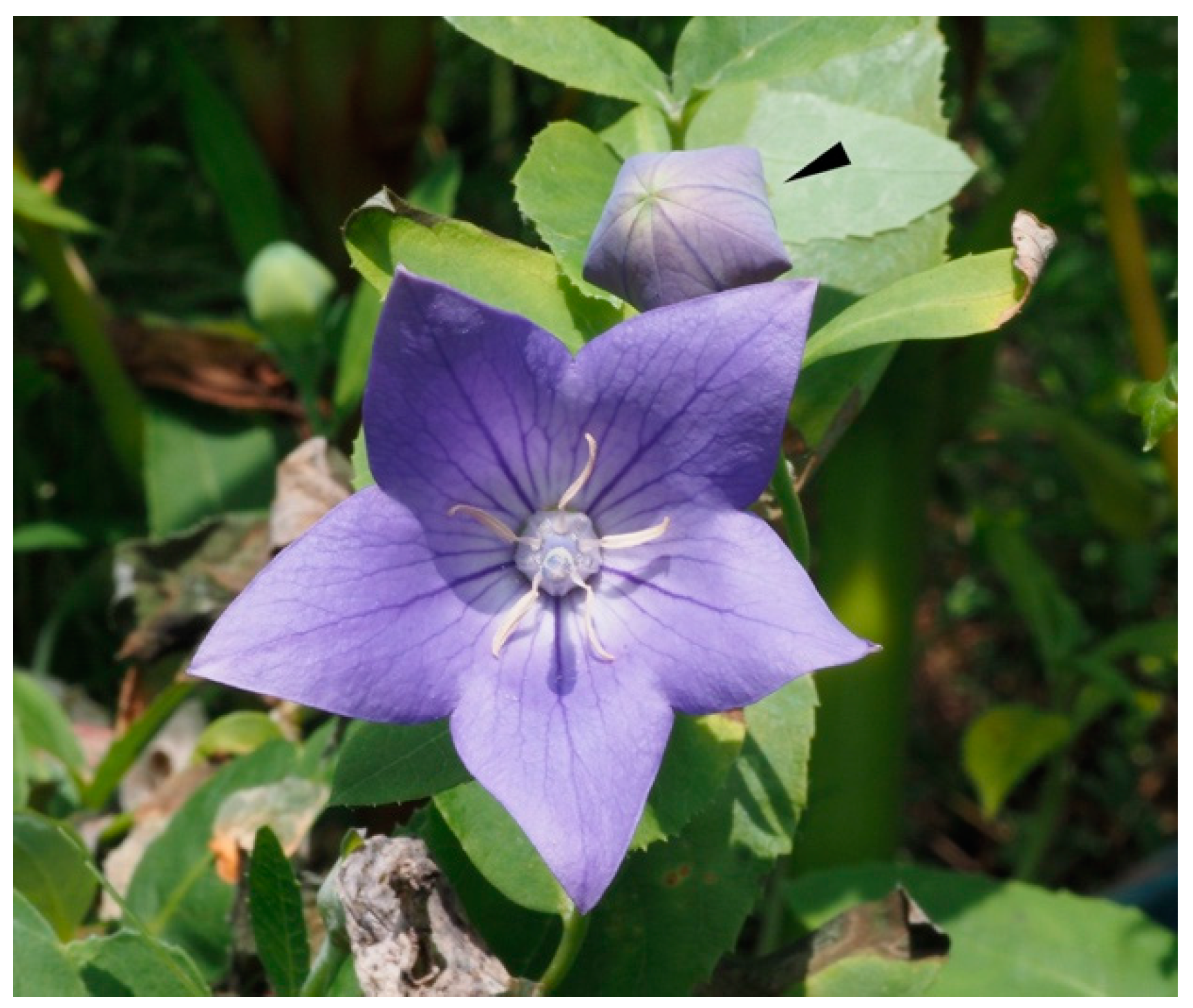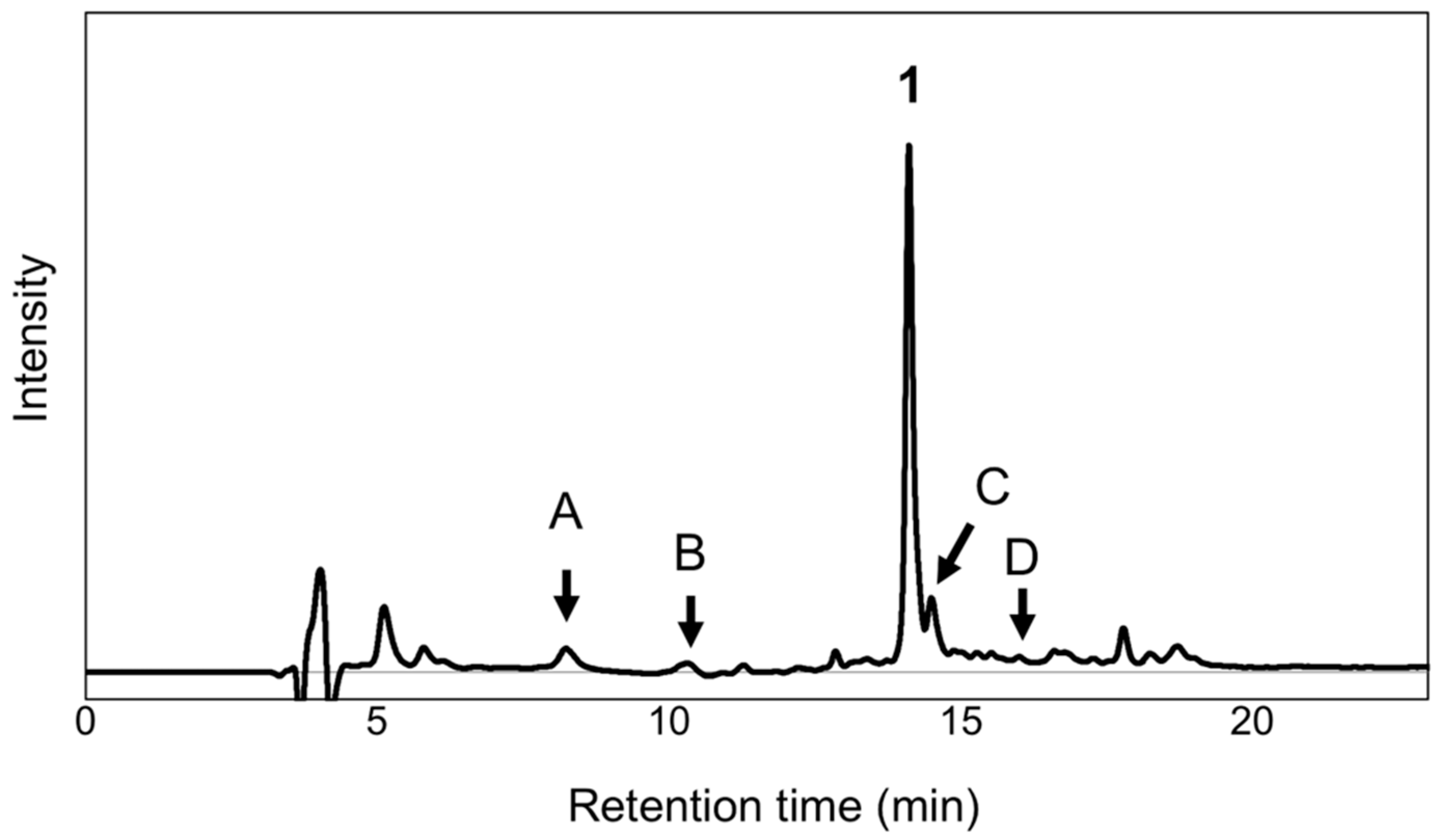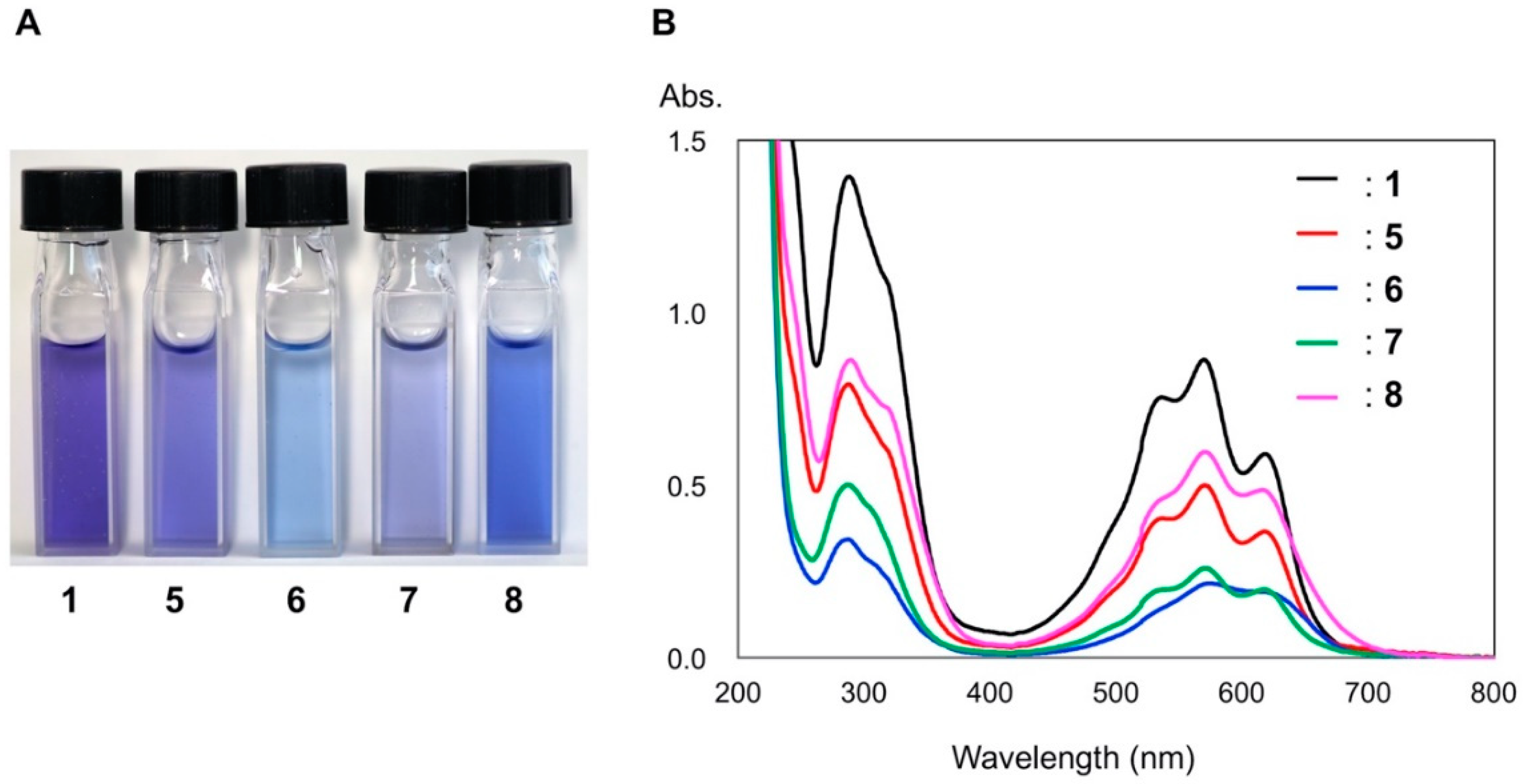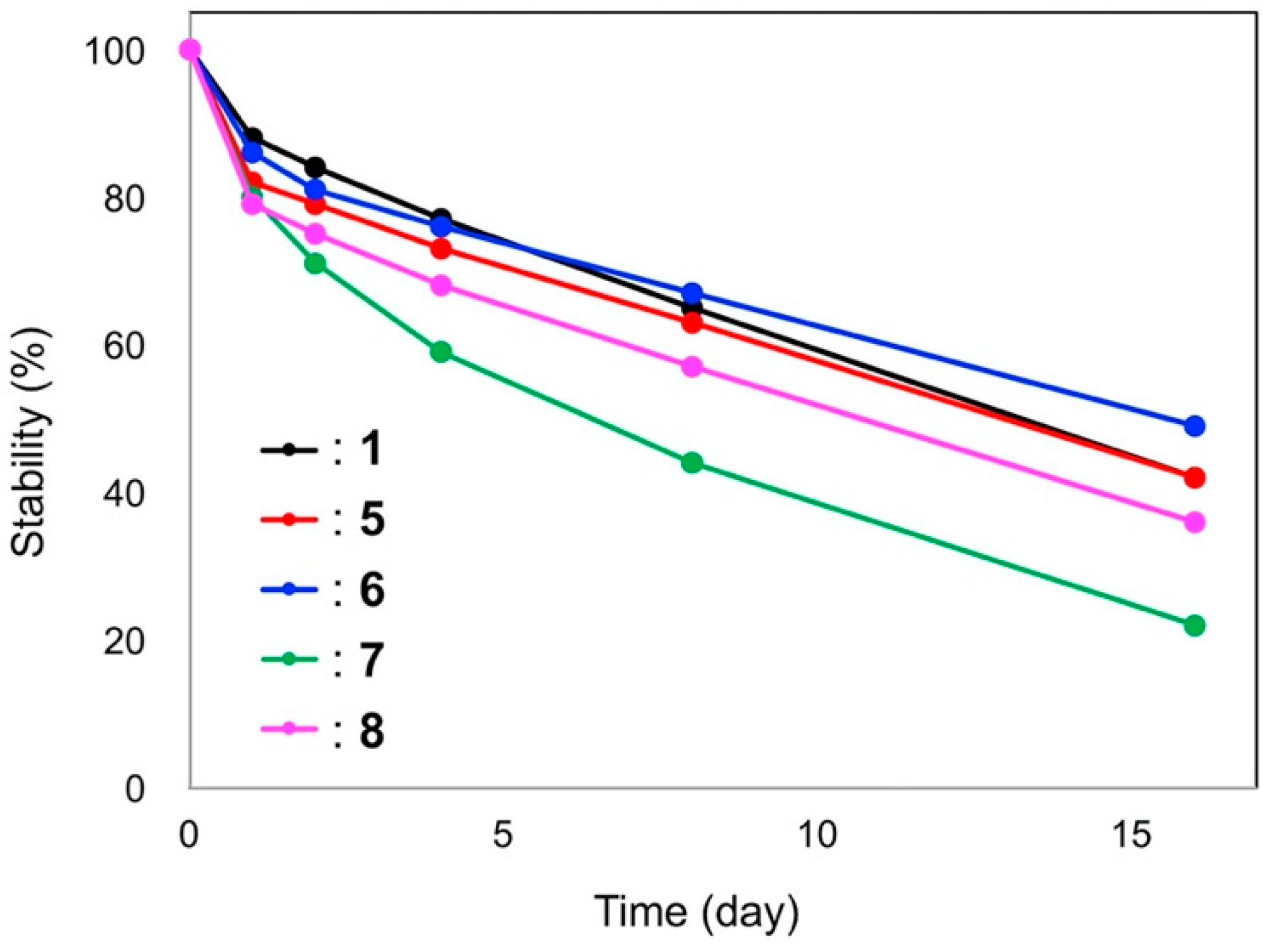Polyacylated Anthocyanins in Bluish-Purple Petals of Chinese Bellflower, Platycodon grandiflorum
Abstract
1. Introduction
2. Results and Discussion
2.1. HPLC Analysis of Minor Anthocyanins
2.2. Purification of Anthocyanins
2.3. Alkaline Hydrolysis of Platyconin (1)
2.4. Structure Elucidation of Anthocyanins
2.5. Color and Stability of Chinese Bellflower Anthocyanins
3. Materials and Methods
3.1. Plant Materials
3.2. General
3.3. Extraction of Petals for HPLC Analysis
3.4. Purification of Anthocyanins 1 and 3–8
3.5. Alkaline Hydrolysis of 1
3.6. Stability of Anthocyanins
4. Conclusions
Supplementary Materials
Author Contributions
Funding
Data Availability Statement
Acknowledgments
Conflicts of Interest
References
- Goto, T.; Tamura, H.; Kawai, T.; Hoshino, T.; Harada, N.; Kondo, T. Chemistry of metalloanthocyanins. Annal. New York Acd. Sci. 1986, 471, 155–173. [Google Scholar] [CrossRef]
- Goto, T.; Kondo, T. Structure and molecular association of anthocyanins Variation of flower color. Angew. Chem. Int. Ed. Engle. 1991, 30, 17–33. [Google Scholar] [CrossRef]
- Honda, T.; Saito, N. Recent progress in the chemistry of polyacylated anthocyanins as flower color pigments. Heterocycles 2002, 56, 633–692. [Google Scholar] [CrossRef]
- Andersen, O.M.; Jordheim, M. The anthocyanins. In Flavonoids Chemistry, Biochemistry and Appllications; Andersen, O.M., Markham, K.R., Eds.; CRC Press: Boca Raton, FL, USA, 2006; pp. 471–551. ISBN 0849320216. [Google Scholar]
- Yoshida, K.; Mori, M.; Kondo, T. Blue flower color development by anthocyanins: From chemical structure to cell physiology. Nat. Prod. Rep. 2009, 26, 884–915. [Google Scholar] [CrossRef] [PubMed]
- Saito, N.; Osawa, Y.; Hayashi, K. Platyconin, a new acylated anthocyanin in Chinese bell-flower, Platycodon grandiflorum. Phytochemistry 1971, 10, 445–447. [Google Scholar] [CrossRef]
- Goto, T.; Kondo, T.; Tamura, H.; Kawahori, K. Structure of platyconin, a diacylated anthocyanin isolated from the Chinese bell-flower Platycodon grandiflorum. Tetrahedron Lett. 1938, 24, 2181–2184. [Google Scholar] [CrossRef]
- Brandt, K.; Kondo, T.; Aoki, H.; Goto, T. Structure and biosynthesis of anthocyanins in flowers of Campanula. Phytochemistry 1963, 33, 209–212. [Google Scholar] [CrossRef]
- Kondo, T.; Oki, K.; Yoshida, K.; Goto, T. Structure of violdelphin, an anthocyanin from violet flower of Delphinium hybridum. Chem. Lett. 1990, 1, 137–138. [Google Scholar] [CrossRef]
- Kondo, T.; Suzuki, K.; Yoshida, K.; Oki, K. Structure of cyanodelphin, a tetra-p-hydroxybenzoated anthocyanin from blue flower of Delphinium hybridum. Tetrahedron Lett. 1991, 32, 6375–6378. [Google Scholar] [CrossRef]
- Saito, N.; Tatsuzawa, F.; Yazaki, Y.; Shigihara, A.; Honda, T. 7-Polyacylated delphinidin 3,7-diglucosides from the blue flowers of Leschenaultia cv. Violet Lena. Phytochemistry 2007, 68, 673–679. [Google Scholar] [CrossRef] [PubMed]
- Mori, M.; Ito, D.; Miki, N.; Kondo, T.; Yoshida, K. Structure of tecophilin, a tri-caffeoylanthocyanin from the blue petals of Tecophilaea cyanocrocus, and the mechanism of blue color development. Tetrahedron 2014, 70, 8657–8664. [Google Scholar] [CrossRef]
- Yoshida, K.; Oyama, K.-i.; Kondo, T. Structure of Polyacylated Anthocyanins and Their UV Protective Effect. In Recent Advances in Polyphenol Research, Volume 5; Yoshida, K., Cheynier, V., Quideau, S., Eds.; Wiley-Blackwell Publishing: Chichester, UK, 2017; pp. 171–192. ISBN 9781118883266. [Google Scholar]
- Moloney, M.; Robbins, R.J.; Collins, T.; Kondo, T.; Yoshida, K.; Dangles, O. Red cabbage anthocyanins: The influence of D-glucose acylation by hydroxycinnamic acids on their structural transformations in acidic to mildly alkaline conditions and on the resulting color. Dye. Pigment. 2018, 158, 342–352. [Google Scholar] [CrossRef]
- Nishizaki, Y.; Yasunaga, M.; Okamoto, E.; Okamoto, M.; Hirose, Y.; Yamaguchi, M.; Ozeki, Y.; Sasaki, N. p-Hydroxybensoyl-glucose is a zwitter donor for the biosynthesis of 7-polyacylated anthocyanin in Delphinium. Plant Cell. 2013, 25, 4150–4165. [Google Scholar] [CrossRef] [PubMed]
- Sasaki, N.; Nishizaki, Y.; Ozeki, Y.; Miyahara, T. The role of acyl-glucose in anthocyanin modifications. Molecules 2014, 19, 18747–18766. [Google Scholar] [CrossRef] [PubMed]





| Molecular Ion Peak (Obs.) | Calcd. | Molecular Formula | |
|---|---|---|---|
| 1 | 1421.3825 | 1421.3826 | C63H73O37 |
| 5 | 1275.3246 | 1275.3240 | C57H63O33 |
| 6 | 1405.3876 | 1405.3879 | C63H73O36 |
| 7 | 1405.3876 | 1405.3864 | C63H73O36 |
| 8 | 1259.3297 | 1259.3291 | C57H63O32 |
| 1 | 5 | 6 | 7 | 8 | |||||||||||||||||
|---|---|---|---|---|---|---|---|---|---|---|---|---|---|---|---|---|---|---|---|---|---|
| 1H | 13C | 1H | 13C | 1H | 13C | 1H | 13C | 1H | 13C | ||||||||||||
| δ (ppm) | multi. | J (Hz) | δ (ppm) | δ (ppm) | multi. | J (Hz) | δ (ppm) | δ (ppm) | multi. | J (Hz) | δ (ppm) | δ (ppm) | multi. | J (Hz) | δ (ppm) | δ (ppm) | multi. | J (Hz) | δ (ppm) | ||
| Del | 2 | 162.2 | 162.4 | 162.4 | 162.1 | 162.9 | |||||||||||||||
| 3 | 145.9 | 145.8 | 145.9 | 145.9 | 145.9 | ||||||||||||||||
| 4 | 8.60 | s | 131.7 | 8.68 | s | 131.8 | 8.56 | s | 131.7 | 8.61 | s | 131.9 | 8.70 | s | 131.8 | ||||||
| 5 | 156.0 | 156.2 | 155.9 | 156.0 | 159.4 | ||||||||||||||||
| 6 | 6.77 | d | 1.5 | 104.0 | 6.86 | d | 2.5 | 104.1 | 6.72 | brs | 104.3 | 6.75 | br. d | 1.5 | 1041.0 | 6.77 | d | 1.5 | 103.1 | ||
| 7 | 165.5 | 165.7 | 165.5 | 165.6 | 165.6 | ||||||||||||||||
| 8 | 6.98 | brd | 1.5 | 93.1 | 6.70 | br.d | 2.5 | 93.1 | 7.04 | brs | 93.1 | 7.00 | br. s | 93.0 | 7.00 | br. d | 1.5 | 93.5 | |||
| 9 | 154.5 | 154.5 | 154.5 | 154.6 | 154.7 | ||||||||||||||||
| 10 | 112.2 | 112.2 | 112.1 | 112.3 | 112.2 | ||||||||||||||||
| 1’ | 118.5 | 118.6 | 118.4 | 118.7 | 118.4 | ||||||||||||||||
| 2’ | 7.81 | brs | 112.2 | 7.86 | d | 2.5 | 111.8 | 7.85 | brs | 111.9 | 7.88 | br. s | 111.9 | 7.76 | br. s | 112.1 | |||||
| 3’ | 145.0 | 144.8 | 144.9 | 144.8 | 145.9 | ||||||||||||||||
| 4’ | 146.3 | 146.4 | 147.1 | 146.4 | 145.9 | ||||||||||||||||
| 5’ | 145.0 | 144.8 | 144.9 | 144.8 | 145.0 | ||||||||||||||||
| 6’ | 7.81 | brs | 112.2 | 8.29 | dd | 2.5, 8.5 | 112.2 | 7.85 | brs | 111.9 | 7.88 | br. s | 111.9 | 7.76 | br. s | 112.1 | |||||
| G1 | 1 | 5.29 | d | 7.5 | 101.7 | 5.31 | d | 6.5 | 104.1 | 5.24 | d | 7.8 | 101.9 | 5.32 | br.d | 7.5 | 101.5 | 5.24 | d | 7.5 | 102.0 |
| 2 | 3.85 | dd | 7.5, 9.5 | 73.1 | 3.89 | dd | 6.5, 8.0 | 73.2 | 3.80 | dd | 7.8, 9.5 | 73.1 | 3.81 | dd | 7.5, 9.5 | 73.1 | 3.89 | dd | 7.5, 9.5 | 73.1 | |
| 3 | 3.60 | dd | 8.0, 9.5 | 76.4 | 3.61 | dd | 8.0, 9.0 | 76.7 | 3.57 | t | 9.5 | 76.4 | 3.61 | t | 9.5 | 75.8 | 3.60 | dd | 8.0, 9.5 | 76.4 | |
| 4 | 3.54 | t | 9.5 | 69.6 | 3.59 | t | 9.0 | 69.8 | 3.49 | t | 9.5 | 70.0 | 3.55 | t | 9.5 | 69.6 | 3.49 | t | 9.5 | 69.9 | |
| 5 | 3.79 | m | 76.5 | 3.70 | ddd | 2.5, 5.5, 9.0 | 77.8 | 3.78 | m | 76.4 | 3.80 | m | 76.4 | 3.80 | br. dt | 1.5, 9.5 | 76.6 | ||||
| 6a | 4.26 | m | 66.4 | 4.13 | dd | 2.5, 12.0 | 61.2 | 4.27 | brd | 10.5 | 66.7 | 4.28 | dd | 9.5, 12.0 | 66.4 | 4.20 | br. dd | 1.5, 12.0 | 66.6 | ||
| 6b | 3.79 | m | 3.98 | dd | 5.5, 12.0 | 3.80 | m | 3.80 | m | 3.73 | br. d | 9.5,12.0 | |||||||||
| G2 | 1 | 5.19 | d | 7.5 | 100.4 | 5.18 | d | 7.5 | 100.3 | 5.21 | d | 7.8 | 100.0 | 5.20 | br. d | 7.5 | 100.4 | 4.92 | d | 7.5 | 99.9 |
| 2 | 3.73 | dd | 7.5, 9.5 | 72.8 | 3.72 | dd | 7.5, 9.0 | 72.8 | 3.72 | dd | 7.8, 9.5 | 72.8 | 3.74 | br. dd | 7.5, 9.5 | 72.8 | 3.67 | dd | 7.5, 9.5 | 76.2 | |
| 3 | 3.60 | t | 9.5 | 75.8 | 3.58 | t | 9.0 | 76.3 | 3.59 | t | 9.5 | 76.3 | 3.61 | br. t | 9.5 | 76.3 | 3.59 | t | 9.5 | 76.5 | |
| 4 | 3.49 | t | 9.5 | 70.7 | 3.48 | t | 9.0 | 69.7 | 3.47 | t | 9.5 | 71.8 | 3.49 | br. t | 9.5 | 70.7 | 3.46 | t | 9.5 | 70.7 | |
| 5 | 3.99 | ddd | 2.0, 9.5, 10.0 | 74.6 | 3.95 | ddd | 2.5, 5.5, 9.0 | 74.6 | 4.00 | m | 74.7 | 4.03 | br. ddd | 2.0, 9.5, 10.0 | 74.6 | 3.91 | br. m | 74.6 | |||
| 6a | 4.73 | dd | 10.0, 12.0 | 64.4 | 4.74 | dd | 2.5, 12.0 | 64.4 | 4.75 | d | 12.0 | 64.4 | 4.67 | br. dd | 10.0, 12.0 | 64.6 | 4.26 | dd | 10.0, 12.0 | 63.9 | |
| 6b | 4.37 | dd | 2.0, 12.0 | 4.36 | dd | 5.5, 12.0 | 4.37 | dd | 9.0, 12,0 | 4.42 | br. dd | 2.0, 12.0 | 4.83 | dd | 2.0, 12.0 | ||||||
| G3 | 1 | 4.92 | d | 7.5 | 100.5 | 4.96 | d | 7.5 | 100.4 | 4.93 | d | 7.5 | 100.5 | 5.01 | br. d | 7.5 | 99.3 | 4.92 | d | 7.5 | 100.7 |
| 2 | 3.61 | dd | 7.5, 9.5 | 73.2 | 3.61 | dd | 7.5, 9.0 | 73.0 | 3.61 | dd | 7.5, 9.5 | 73.2 | 3.56 | br. dd | 7.5, 9.5 | 73.0 | 3.61 | dd | 7.5, 9.5 | 73.2 | |
| 3 | 3.70 | t | 9.5 | 76.1 | 3.69 | t | 9.0 | 76.2 | 3.71 | t | 9.5 | 76.2 | 3.70 | br. t | 9.5 | 76.6 | 3.70 | t | 9.5 | 73.0 | |
| 4 | 3.38 | t | 9.5 | 71.6 | 3.39 | t | 9.0 | 71.4 | 3.97 | t | 9.5 | 71.6 | 3.37 | br. t | 9.5 | 71.6 | 3.38 | t | 9.5 | 71.2 | |
| 5 | 3.80 | m | 73.5 | 4.00 | ddd | 2.5, 5.5, 9.0 | 73.3 | 3.97 | m | 73.6 | 4.00 | br. m | 73.3 | 3.93 | m | 73.9 | |||||
| 6a | 4.73 | brd | 2.5, 12.0 | 64.4 | 4.80 | dd | 2.5, 12.0 | 64.5 | 4.75 | brd | 11.0 | 64.3 | 4.77 | br. dd | 2.5, 12.0 | 64.5 | 4.71 | br. d | 2.5, 12.0 | 63.7 | |
| 6b | 3.80 | m | 3.95 | dd | 5.5, 12.0 | 4.02 | brd | 11.0 | 3.91 | br. m | 4.38 | dd | 9.0, 12.0 | ||||||||
| G4 | 1 | 4.60 | d | 7.5 | 101.4 | 4.53 | d | 7.5 | 101.6 | 4.73 | d | 7.8 | 99.7 | 4.57 | br. d | 7.5 | 101.0 | ||||
| 2 | 3.47 | dd | 7.5, 9.5 | 73.3 | 3.49 | dd | 7.5, 9.0 | 73.3 | 3.44 | dd | 7.8, 9.5 | 72.7 | 3.46 | br. dd | 7.5, 9.5 | 73.2 | |||||
| 3 | 3.60 | t | 9.5 | 76.3 | 3.60 | t | 9 | 75.8 | 3.56 | t | 9.5 | 76.5 | 3.61 | br. t | 9.5 | 76.5 | |||||
| 4 | 3.46 | t | 9.5 | 69.8 | 3.48 | t | 9 | 70.7 | 3.47 | m | 70.0 | 3.50 | br. t | 9.5 | 69.8 | ||||||
| 5 | 3.50 | m | 76.5 | 3.43 | ddd | 2.5, 5.5, 9.0 | 76.4 | 3.47 | m | 76.3 | 3.48 | br. m | 76.3 | ||||||||
| 6a | 3.85 | dd | 2.0, 12.0 | 60.8 | 3.80 | dd | 2.5,12.5 | 60.6 | 3.89 | dd | 1.5, 11.0 | 61.0 | 3.83 | br. dd | 2.0, 12.0 | 60.7 | |||||
| 6b | 3.75 | dd | 4.5, 12.0 | 3.75 | dd | 5.5, 12.5 | 3.75 | brd | 11.0 | 3.77 | br. dd | 4.5, 12.0 | |||||||||
| Rha | 1 | 4.89 | brd | 1.0 | 101.7 | 4.86 | brs | 100.9 | 4.87 | br. s | 101.1 | 4.81 | br. d | 1.0 | 101.7 | ||||||
| 2 | 4.09 | dd | 1.0, 3.5 | 70.3 | 4.05 | brdd | 1.5, 3.0 | 70.4 | 4.11 | br. d | 3.5 | 70.3 | 4.01 | dd | 1.0, 3.5 | 70.3 | |||||
| 3 | 3.72 | dd | 3.5, 9.5 | 71.2 | 3.75 | dd | 3.0, 9.5 | 71.2 | 3.72 | dd | 3.5, 9.5 | 71.2 | 3.74 | dd | 3.5, 9.5 | 71.2 | |||||
| 4 | 3.40 | t | 9.5 | 72.5 | 3.43 | t | 9.5 | 69.8 | 3.40 | t | 9.5 | 72.5 | 3.40 | t | 9.5 | 72.5 | |||||
| 5 | 3.67 | dt | 6.0, 9.5 | 70.3 | 3.65 | dt | 6.5, 9.5 | 68.6 | 3.66 | m | 68.6 | 3.65 | dt | 6.0, 9.5 | 68.5 | ||||||
| 6 | 1.26 | d | 6.0 | 16.5 | 1.28 | d | 6.5 | 16.6 | 1.25 | dd | 6.0 | 16.5 | 1.25 | d | 6.0 | 16.5 | |||||
| acyl1 | 1 | 128.7 | 128.6 | 128.6 | 127.8 | 128.7 | |||||||||||||||
| 2 | 6.80 | d | 2.5 | 116.9 | 6.88 | d | 2.5 | 116.9 | 6.87 | d | 1.5 | 116.5 | 7.33 | br. d | 8.5 | 129.4 | 6.80 | d | 2.5 | 115.9 | |
| 3 | 146.3 | 146.4 | 146.5 | 6.82 | br. d | 8.5 | 115.9 | 146.4 | |||||||||||||
| 4 | 147.1 | 147.2 | 147.1 | 159.2 | 147.1 | ||||||||||||||||
| 5 | 6.72 | d | 8.5 | 115.1 | 6.79 | d | 8.5 | 115.0 | 6.75 | d | 8.5 | 115.3 | 6.82 | br. d | 8.5 | 119.9 | 6.73 | d | 8.5 | 115.3 | |
| 6 | 6.67 | dd | 2.5, 8.5 | 118.4 | 6.86 | dd | 2.5, 8.5 | 118.0 | 6.73 | dd | 1.5, 8.5 | 118.4 | 7.33 | br. d | 8.5 | 129.4 | 6.51 | dd | 2.5, 8.5 | 119.1 | |
| α | 5.84 | d | 15.5 | 115.2 | 6.50 | d | 15.5 | 118.5 | 6.45 | d | 16.0 | 115.0 | 6.55 | d | 16.0 | 114.7 | 6.28 | d | 15.5 | 115.3 | |
| β | 7.13 | d | 15.5 | 144.7 | 7.55 | d | 15.5 | 145.2 | 7.53 | d | 16.0 | 145.3 | 7.64 | d | 16.0 | 144.9 | 7.38 | d | 15.5 | 144.9 | |
| CO | 167.5 | 167.4 | 167.3 | 167.7 | 167.3 | ||||||||||||||||
| acyl2 | 1 | 129.1 | 128.7 | 128.0 | 129.0 | 126.0 | |||||||||||||||
| 2 | 6.64 | d | 2.5 | 113.6 | 6.91 | d | 2.5 | 113.6 | 7.09 | d | 8.5 | 128.6 | 6.78 | br. s | 113.5 | 6.80 | d | 2.5 | 113.5 | ||
| 3 | 146.8 | 145.8 | 6.72 | d | 8.5 | 116.4 | 146.6 | 146.2 | |||||||||||||
| 4 | 146.7 | 146.8 | 158.8 | 146.8 | 147.8 | ||||||||||||||||
| 5 | 6.63 | d | 8.5 | 115.8 | 6.68 | d | 8.5 | 115.6 | 6.72 | d | 8.5 | 116.4 | 6.55 | br. d | 8.5 | 115.3 | 6.49 | d | 8.5 | 115.0 | |
| 6 | 6.57 | dd | 2.5, 8.5 | 120.4 | 6.47 | dd | 2.5, 8.5 | 121.0 | 7.09 | d | 8.5 | 128.6 | 6.32 | br. d | 8.5 | 120.4 | 6.54 | dd | 2.5, 8.5 | 121.2 | |
| α | 5.77 | d | 15.5 | 116.9 | 6.16 | d | 15.5 | 116.9 | 6.14 | d | 16.0 | 116.5 | 6.12 | d | 16.0 | 117.0 | 6.09 | d | 15.5 | 114.1 | |
| β | 6.99 | d | 15.5 | 143.2 | 7.01 | d | 15.5 | 143.4 | 7.12 | d | 16.0 | 143.0 | 6.90 | br. d | 16.0 | 143.0 | 7.21 | d | 15.5 | 144.8 | |
| CO | 166.8 | 167.0 | 166.9 | 166.9 | 167.3 | ||||||||||||||||
Publisher’s Note: MDPI stays neutral with regard to jurisdictional claims in published maps and institutional affiliations. |
© 2021 by the authors. Licensee MDPI, Basel, Switzerland. This article is an open access article distributed under the terms and conditions of the Creative Commons Attribution (CC BY) license (https://creativecommons.org/licenses/by/4.0/).
Share and Cite
Kondo, T.; Hagihara, S.; Takaya, Y.; Yoshida, K. Polyacylated Anthocyanins in Bluish-Purple Petals of Chinese Bellflower, Platycodon grandiflorum. Int. J. Mol. Sci. 2021, 22, 4044. https://doi.org/10.3390/ijms22084044
Kondo T, Hagihara S, Takaya Y, Yoshida K. Polyacylated Anthocyanins in Bluish-Purple Petals of Chinese Bellflower, Platycodon grandiflorum. International Journal of Molecular Sciences. 2021; 22(8):4044. https://doi.org/10.3390/ijms22084044
Chicago/Turabian StyleKondo, Tadao, Seiji Hagihara, Yoshiaki Takaya, and Kumi Yoshida. 2021. "Polyacylated Anthocyanins in Bluish-Purple Petals of Chinese Bellflower, Platycodon grandiflorum" International Journal of Molecular Sciences 22, no. 8: 4044. https://doi.org/10.3390/ijms22084044
APA StyleKondo, T., Hagihara, S., Takaya, Y., & Yoshida, K. (2021). Polyacylated Anthocyanins in Bluish-Purple Petals of Chinese Bellflower, Platycodon grandiflorum. International Journal of Molecular Sciences, 22(8), 4044. https://doi.org/10.3390/ijms22084044






